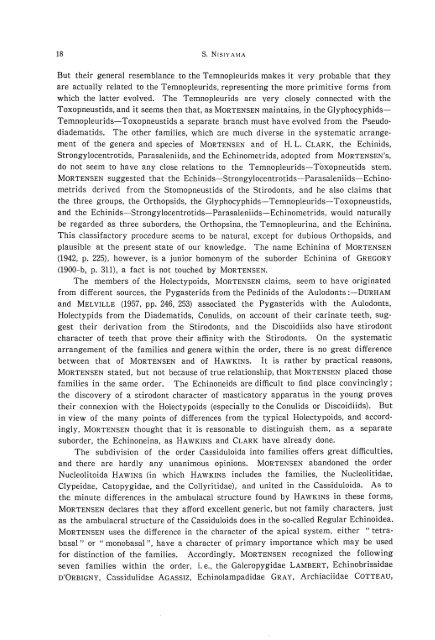the echinoid fauna from japan and adjacent regions part i
the echinoid fauna from japan and adjacent regions part i
the echinoid fauna from japan and adjacent regions part i
You also want an ePaper? Increase the reach of your titles
YUMPU automatically turns print PDFs into web optimized ePapers that Google loves.
18 S. NISIYAMA<br />
But <strong>the</strong>ir general resemblance to <strong>the</strong> Temnopleurids makes it very probable that <strong>the</strong>y<br />
are actually related to <strong>the</strong> Temnopleurids, representing <strong>the</strong> more primitive forms <strong>from</strong><br />
which <strong>the</strong> latter evolved. The Temnopleurids are very closely connected with <strong>the</strong><br />
Toxopneustids, <strong>and</strong> it seems <strong>the</strong>n that, as MORTENSEN maintains, in <strong>the</strong> Glyphocyphids<br />
Temnopleurids-Toxopneustids a separate branch must have evolved <strong>from</strong> <strong>the</strong> Pseudo·<br />
diadematids. The o<strong>the</strong>r families, which are much diverse in <strong>the</strong> systematic arrange·<br />
ment of <strong>the</strong> genera <strong>and</strong> species of MORTENSEN <strong>and</strong> of H. L. CLARK, <strong>the</strong> Echinids,<br />
Strongylocentrotids, Parasaleniids, <strong>and</strong> <strong>the</strong> Echinometrids, adopted <strong>from</strong> MORTENSEN'S,<br />
do not seem to have any close relations to <strong>the</strong> Temnopleurids-Toxopneutids stem.<br />
MORTENSEN suggested that <strong>the</strong> Echinids-Strongylocentrotids-Parasaleniids-Echino·<br />
metrids derived <strong>from</strong> <strong>the</strong> Stomopneustids of <strong>the</strong> Stirodonts, <strong>and</strong> he also claims that<br />
<strong>the</strong> three groups, <strong>the</strong> Orthopsids, <strong>the</strong> Glyphocyphids-Temnopleurids-Toxopneustids,<br />
<strong>and</strong> <strong>the</strong> Echinids-Strongylocentrotids-Parasaleniids-Echinometrids, would naturally<br />
be regarded as three suborders, <strong>the</strong> Orthopsina, <strong>the</strong> Temnopleurina, <strong>and</strong> <strong>the</strong> Echinina.<br />
This classifactory procedure seems to be natural, except for dubious Orthopsids, <strong>and</strong><br />
plausible at <strong>the</strong> present state of our knowledge. The name Echinina of MORTENSEN<br />
(1942, p. 225), however, is a junior homonym of <strong>the</strong> suborder Echinina of GREGORY<br />
(1900-b, p. 311), a fact is not touched by MORTENSEN.<br />
The members of <strong>the</strong> Holectypoids, MORTENSEN claims, seem to have originated<br />
<strong>from</strong> different sources, <strong>the</strong> Pygasterids <strong>from</strong> <strong>the</strong> Pedinids of <strong>the</strong> Aulodonts :-DURHAM<br />
<strong>and</strong> MELVILLE (1957, pp. 246, 253) associated <strong>the</strong> Pygasterids with <strong>the</strong> Aulodonts,<br />
Holectypids <strong>from</strong> <strong>the</strong> Diadematids, Co nul ids, on account of <strong>the</strong>ir carinate teeth, suggest<br />
<strong>the</strong>ir derivation <strong>from</strong> <strong>the</strong> Stirodonts, <strong>and</strong> <strong>the</strong> Discoidiids also have stirodont<br />
character of teeth that prove <strong>the</strong>ir affinity with <strong>the</strong> Stirodonts. On <strong>the</strong> systematic<br />
arrangement of <strong>the</strong> families <strong>and</strong> genera within <strong>the</strong> order, <strong>the</strong>re is no great difference<br />
between that of MORTENSEN <strong>and</strong> of HAWKINS. It is ra<strong>the</strong>r by practical reasons,<br />
MORTENSEN stated, but not because of true relationship, that MORTENSEN placed those<br />
families in <strong>the</strong> same order. The Echinoneids are difficult to find place convincingly;<br />
<strong>the</strong> discovery of a stirodont character of masticatory apparatus in <strong>the</strong> young proves<br />
<strong>the</strong>ir connexion with <strong>the</strong> Holectypoids (especially to <strong>the</strong> Conulids or Discoidiids). But<br />
in view of <strong>the</strong> many points of differences <strong>from</strong> <strong>the</strong> typical Holectypoids, <strong>and</strong> accordingly,<br />
MORTENSEN thought that it is reasonable to distinguish <strong>the</strong>m, as a separate<br />
suborder, <strong>the</strong> Echinoneina, as HAWKINS <strong>and</strong> CLARK have already done.<br />
The subdivision of <strong>the</strong> order Cassiduloida into families offers great difficulties,<br />
<strong>and</strong> <strong>the</strong>re are hardly any unanimous opinions. MORTENSEN ab<strong>and</strong>oned <strong>the</strong> order<br />
Nucleolitoida HAWINS (in which HAWKINS includes <strong>the</strong> families, <strong>the</strong> Nucleolitidae,<br />
Clypeidae, Catopygidae, <strong>and</strong> <strong>the</strong> Collyritidae), <strong>and</strong> united in <strong>the</strong> Cassiduloida. As to<br />
<strong>the</strong> minute differences in <strong>the</strong> ambulacal structure found by HAWKINS in <strong>the</strong>se forms,<br />
MORTENSEN declares that <strong>the</strong>y afford excellent generic, but not family characters, just<br />
as <strong>the</strong> ambulacral structure of <strong>the</strong> Cassiduloids does in <strong>the</strong> so-called Regular Echinoidea.<br />
MORTENSEN uses <strong>the</strong> difference in <strong>the</strong> character of <strong>the</strong> apical system, ei<strong>the</strong>r "tetra·<br />
basal" or " monobasal ", have a character of primary importance which may be used<br />
for distinction of <strong>the</strong> families. Accordingly, MORTENSEN recognized <strong>the</strong> following<br />
seven families within <strong>the</strong> order, i. e., <strong>the</strong> Galeropygidae LAMBERT, Echinobrissidae<br />
D'ORBIGNY, Cassidulidae AGASSIZ, Echinolampadidae GRAY, Archiaciidae COTTEAU,












